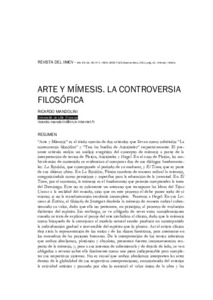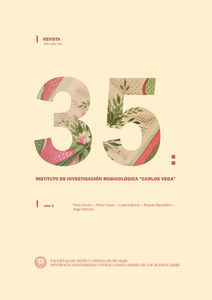Por favor, use este identificador para citar o enlazar este ítem:
https://repositorio.uca.edu.ar/handle/123456789/12372| Título: | Arte y mímesis : la controversia filosófica Art and mimesis : the philosophical controversy |
Autor: | Mandolini, Ricardo | Palabras clave: | ARTE; MIMESIS; MUSICA; FILOSOFIA; HERMENEUTICA; EXEGESIS | Fecha de publicación: | 2021 | Editorial: | Pontificia Universidad Católica Argentina. Facultad de Artes y Ciencias Musicales. Instituto de Investigación Musicológica Carlos Vega | Cita: | Mandolini, R. Arte y mímesis : la controversia filosófica [en línea]. Revista del Instituto de Investigación Musicológica “Carlos Vega”. 2021, 35 (1). Disponible en: https://repositorio.uca.edu.ar/handle/123456789/12372 | Resumen: | Resumen: “Arte y Mímesis” es el título común de dos artículos que llevan como subtítulos “La
controversia filosófica” y “Tras las huellas de Aristóteles” respectivamente. El presente
artículo realiza un análisis exegético del concepto de mímesis a partir de la
interpretación de textos de Platón, Aristóteles y Hegel. En el caso de Platón, las ambivalencias
de contenido se evidencian al comparar dos de sus diálogos fundamentales:
La República, que corresponde al período de su madurez, y El Timeo, que es parte
de sus últimas obras. En La República, Platón condena de manera radical la mímesis,
categorizándola como perniciosa y superflua para la educación de la juventud. En El
Timeo, por el contrario, la mímesis es el fundamento que permite comprender la tarea
del Demiurgo. Este no es solamente un artesano que transpone las Ideas del Topus
Uranus a la realidad del mundo, sino que en este proceso él debe poner todo de sí
mismo; si no la transformación resultaría incompleta. Pasemos a Hegel: En sus Lecciones
de Estética, el filósofo de Stuttgart desdeña la mímesis de manera radical subestimando
su valor, dado que ella no pertenece, en principio, al proceso de evolución
dialéctica del espíritu. Sin embargo, se ve obligado de rever estas consideraciones
cuando se trata de explicar el pasaje del arte simbólico al clásico, dado que la mímesis
como búsqueda de la semejanza al modelo natural resulta producir en contrapartida
la individuación gradual e irreversible del espíritu que lo plasma. Así el artista clásico
deja atrás la representación de los mitos y de los dioses hieráticos, para internarse en
los meandros de las pasiones humanas. De la interpretación de los textos inferimos
que ambos idealismos, platónico y absoluto, presentan fuertes inconsecuencias respecto
de la mímesis, y, pese a sus intentos de subestimarla y de dejarla de lado, se ven
obligados a revenir sobre ella finalmente como una pieza indispensable para completar
sus respectivos sistemas. No es casual que ambos idealismos interpreten las artes
dentro de la globalidad de sus respectivas interpretaciones, encorsetando del exterior
la actividad artística y pasando por alto lo esencial: el valor único de la obra y las emociones que ella despierta. Aquí nuestra investigación nos conduce inevitablemente
hacia la concepción de mímesis de Aristóteles. Ocurre que, a pesar de que en ninguna
parte el Estagirita da una definición clara de este concepto, La Poética nos permite
abordar los diversos casos de aplicación de la mímesis. Para profundizar la complejidad
de lo que él entiende por este término, hemos debido realizar una lectura transversal
de sus obras clave, deteniéndonos particularmente en la Ética a Nicómaco. Así
descubrimos que, veinte siglos antes que Alexander Baumgarten —considerado el
padre de la estética moderna— la mímesis de Aristóteles abre de par en par las puertas
a una epistemología del arte a partir de reglas que le son propias y distintas a las de
la lógica, donde lo que prima no es la Verdad sino la convicción del que realiza y su
concatenación plausible y verosímil de los eventos. Abstract: “Art and Mimesis” is the common title of two articles subtitled “The Philosophical Controversy” and “In the Footsteps of Aristotle” respectively. “The Philosophical Controversy” undertakes an exegetical analysis of the concept of mimesis by interpreting texts by Plato, Aristotle and Hegel. In the case of Plato, the ambivalences of content are evidenced by comparing two of his fundamental dialogues: The Republic, which corresponds to the period of his maturity, and The Timaeus, which is part of his later works. In the former dialogue, Plato radically condemns mimesis, categorising it as pernicious and superfluous for the education of youth. In the latter dialogue, on the contrary, mimesis is the foundation for understanding the task of the Demiurge. He is not only a craftsman who copies the Ideas of the Topus Uranus into the reality of the world, but in this process he must put everything of himself; otherwise the transformation would be incomplete. Let us turn to Hegel: in his Lectures on Aesthetics, the philosopher disdains mimesis in a radical way by underestimating its value, since it does not belong, in principle, to the process of dialectical evolution of the spirit. However, he is forced to review these considerations when it comes to explaining the transition from symbolic to classical art, since mimesis as a search for resemblance to the natural model turns out to produce in return the gradual and irreversible individuation of the spirit that embodies it. Thus the classical artist leaves behind the representation of myths and hieratic gods to enter the meanderings of human passions. From the interpretation of the texts we infer that both idealisms, Platonic and absolute, present strong inconsistencies with respect to mimesis, and, in spite of their attempts to underestimate it and leave it aside, they are forced to return to it in the end as an indispensable piece to complete their respective systems. It is not by chance that both idealisms interpret the arts within the globality of their respective interpretations, corseting artistic activity from the outside and overlooking the essential: the unique value of the work and the emotions it arouses. Here our investigation inevitably leads us to Aristotle’s conception of mimesis. It so happens that, although nowhere does the Stagirite give a clear definition of this concept, The Poetics allows us to address the various cases of the application of mimesis. In order to delve deeper into the complexity of what Aristotle means by this term, we have had to make a transversal reading of his key works, stopping particularly at the Nicomachean Ethics. Thus, we discover that, twenty centuries before Alexander Baumgarten —considered the father of modern aesthetics— Aristotle’s mimesis opens wide the doors to an epistemology of art based on rules that are proper to it and different from those of logic, where what prevails is not Truth but the conviction of the performer and his plausible and convincing concatenation of events. |
URI: | https://repositorio.uca.edu.ar/handle/123456789/12372 | ISSN: | 2683-7145 | Disciplina: | MUSICA | Derechos: | Acceso abierto | Fuente: | Revista del Instituto de Investigación Musicológica “Carlos Vega”. 2021, 35 (1) |
| Aparece en las colecciones: | IIM - 2021 Año XXXV nro. 35-1 |
Ficheros en este ítem:
| Fichero | Descripción | Tamaño | Formato | |
|---|---|---|---|---|
| arte-mimesis-controversia.pdf | 344,46 kB | Adobe PDF |  Visualizar/Abrir | |
| TAPA_REV35-1.jpg | 832,95 kB | JPEG |  Visualizar/Abrir |
Visualizaciones de página(s)
150
comprobado en 27-abr-2024
Descarga(s)
3.258
comprobado en 27-abr-2024
Google ScholarTM
Ver en Google Scholar
Este ítem está sujeto a una Licencia Creative Commons

